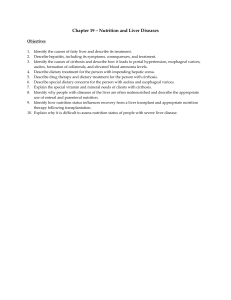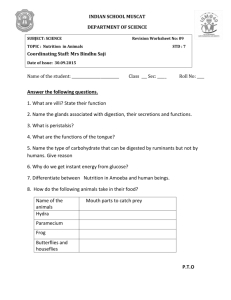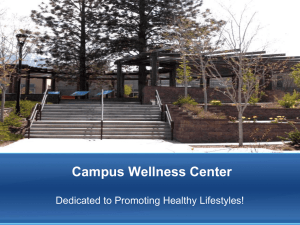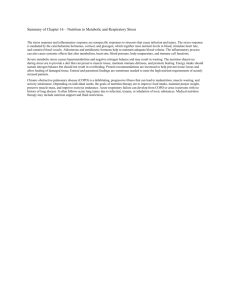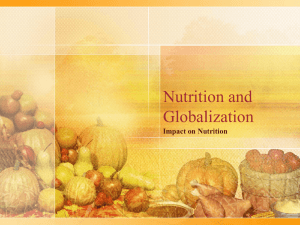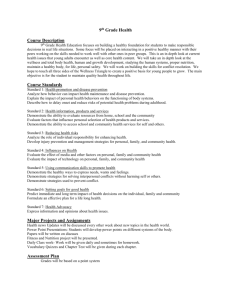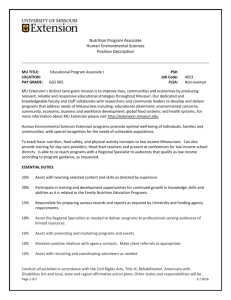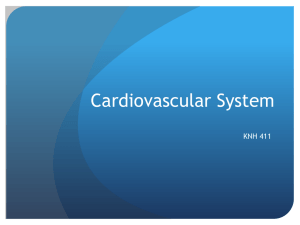MNT Case 3
advertisement
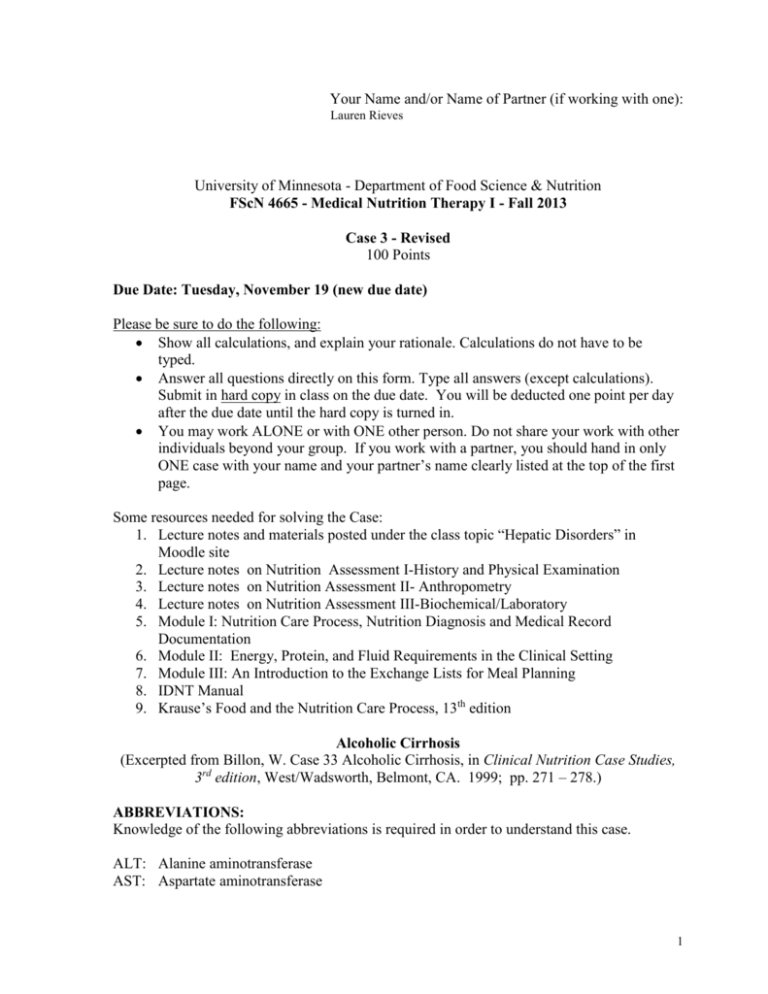
Your Name and/or Name of Partner (if working with one): Lauren Rieves University of Minnesota - Department of Food Science & Nutrition FScN 4665 - Medical Nutrition Therapy I - Fall 2013 Case 3 - Revised 100 Points Due Date: Tuesday, November 19 (new due date) Please be sure to do the following: Show all calculations, and explain your rationale. Calculations do not have to be typed. Answer all questions directly on this form. Type all answers (except calculations). Submit in hard copy in class on the due date. You will be deducted one point per day after the due date until the hard copy is turned in. You may work ALONE or with ONE other person. Do not share your work with other individuals beyond your group. If you work with a partner, you should hand in only ONE case with your name and your partner’s name clearly listed at the top of the first page. Some resources needed for solving the Case: 1. Lecture notes and materials posted under the class topic “Hepatic Disorders” in Moodle site 2. Lecture notes on Nutrition Assessment I-History and Physical Examination 3. Lecture notes on Nutrition Assessment II- Anthropometry 4. Lecture notes on Nutrition Assessment III-Biochemical/Laboratory 5. Module I: Nutrition Care Process, Nutrition Diagnosis and Medical Record Documentation 6. Module II: Energy, Protein, and Fluid Requirements in the Clinical Setting 7. Module III: An Introduction to the Exchange Lists for Meal Planning 8. IDNT Manual 9. Krause’s Food and the Nutrition Care Process, 13th edition Alcoholic Cirrhosis (Excerpted from Billon, W. Case 33 Alcoholic Cirrhosis, in Clinical Nutrition Case Studies, 3rd edition, West/Wadsworth, Belmont, CA. 1999; pp. 271 – 278.) ABBREVIATIONS: Knowledge of the following abbreviations is required in order to understand this case. ALT: Alanine aminotransferase AST: Aspartate aminotransferase 1 BRB: DTs: D5W: Dx: GGT: I.V.: N/G: NH3: NPO: Bright red blood Delirium tremens 5% dextrose in water Diagnosis Gammaglutamyl transferase (or transpeptidase) Intravenous Nasogastric Ammonia Nothing by mouth (nil per os) Patient Hx: Mr. N is a 45-year-old automobile mechanic. He is divorced with two children who are in college. He has long suffered from depression, and has a long-standing history of alcohol abuse. About a year ago, he had been admitted to the hospital for treatment of acute pancreatitis and an enlarged fatty liver. He had been told to follow a low-fat, high protein diet with absolutely no alcohol. He improved for a while, but then went back to drinking. Approximately 6 months ago, he was admitted to the hospital with a diagnosis of Laennec’s cirrhosis with pancreatitis. At that time, he was again discharged with the direction to follow a low-fat, high protein, low sodium diet, and to completely abstain from alcohol. Over the past couple of months he has experienced a gradual decline. Mr. N’s condition has worsened significantly over the past week. He is admitted to the hospital with ascites and pedal edema. His urinary output has been decreasing, and he has not been following his diet at all. Physical Examination/Anthropometric Data: General appearance: Tired-looking male Height: 5’ 11” Admission Weight: 150 lbs Weight today: 155 lbs Weight 2 weeks ago (prior to the development of ascites and peripheral edema): 140 lbs Weight 6 months ago (Usual Body Weight): 170 lbs Ascites and 1+ pedal edema Exhibits loss of muscle mass (temporal, interosseous) and subcutaneous fat (triceps, orbital) Measured REE (today): 1720 kcals/d Nutrition Hx: General: Poor appetite for the past few weeks. He has been eating very little, and has not been receiving the nutrients he needs. He has continued to lose weight. He drinks little water, and reports consuming about 20 fl oz of vodka every day. 24-hour recall: Breakfast: 16 oz coffee (black), 1 Tbsp half and half, 1 tsp sugar, 2 slices white bread, 2 Tbsp butter (stick) Lunch: Spaghetti with meat sauce: 1 c cooked spaghetti noodles, ½ c spaghetti sauce, 1 oz cooked ground beef, 12 fl oz Vodka Dinner: Chicken sandwich, 8 fl oz Vodka 2 Hospital course: After a few days without alcohol, Mr. N began to have DTs and had to be restrained. During this time, he began to hallucinate and use very abusive language. He also started to exhibit asterixis. Blood NH3 was drawn and was 40 units/L. His food and fluid intake dropped to almost nothing. He was receiving D5W by I.V. with added vitamins, minerals, and electrolytes. That night he started throwing up large amounts of BRB. A SengstakenBlakemore tube had to be placed. Mr. N bled so excessively that whole blood had to be administered. His physician added to his Dx the following: 1. Hepatic encephalopathy 2. Portal hypertension 3. Esophageal varices Mr. N was now in a semi-comatose state and had to keep the Sengstaken-Blakemore tube in place for another day. After the tube was removed, Mr. N had a N/G tube in place to low intermittent suction. He was NPO and continued to receive D5W by I.V. with electrolytes, vitamins, and minerals. Mr. N continued to have severe ascites and 2+ pedal edema, with reduced urinary output. He had some blood drawn again, and his blood NH3 was now up to 92 units/L. His prothrombin time was increased above the normal range by 4 seconds. His serum albumin was down to 2.0 g/dL. AST was 2x the ALT level, and GGT was 800 IU/L. New orders for Mr. N included the following: 1. Spironolactone (Aldactone) I.V. 2. Furosemide (Lasix) I.V. 3. Lactulose enema 4. Neomycin via N/G tube 5. D5W at 75 cc/hr The physician requested a nutrition consult for recommendations regarding an appropriate tube feeding and flow rate. UNDERSTANDING THE PATHOPHYSIOLOGY 1. Define the following terms: a. Sengstaken-Blakemore tube (2 points) A tube interted through the nose or mouth to manage upper gastrointestinal hemorrhage due to esophageal varices. It is a double balloon tamponade that consists of a gastric ballon, a esophageal balloon and a gastric suction port. It is only a temporary solution to bleeding. 3 b. Hepatic encephalopathy (AKA portal systemic encephalopathy) (2 points) Hepatic encephalopathy is a decrease in cognitive function that occurs because the liver is no longer able to remove toxic substances from the blood such as ammonia. c. Asterixis (2 points) A tremor of the hand when the wrist is extended. 2. Explain the pathophysiology of esophageal varices and portal hypertension as it relates to liver disease and Mr. N’s bleeding. (4 points) Esophageal varices and portal hypertension are signs of advanced alcoholic cirrhosis. There is increased resistance to blood flow through the liver due to fibrotic reorganization of normal liver architecture causes increased blood pressure in the portal vein. Esophageal varices occur because main blood pathways are blocked so blood is forced through smaller vessels which are not equipt to handle large amounts of blood so they rupture. 4 3. What is the relationship between prothrombin time and liver disease? (4 points) Prothrombin time is a measure of how long it takes blood to clot. There is prolonged prothrombin time during liver dysfunction because the liver synthesizes some clotting factors. 4. Mr. N’s AST was 2X ALT and GGT was 800 IU/L. What do each of these findings tell the physician about Mr. N’s liver? (4 points) When AST is 2x the level of ALT and there is a high GGT, it suggests alcoholic chirossis. AST, ALT and GGT are all enzymes that are abundant in the liver. A normal level of AST is less than 45 IU/L, a normal level of ALT is less than 50 IU/L and a normal level of GGT is less than 85 IU/L. ALT is more specific for liver disease than AST. All three of these findings tell the physician that Mr.N's liver is highly diseased. 5 5. What is the significance of Mr. N’s ammonia level being elevated prior to his bleeding? What is the significance of it being elevated to an even greater degree AFTER his bleeding? (4 points) The liver detoxifies the blood of ammonia by converting ammonia to urea. Mr.N's elevated ammonia (40 units/L) level prior to his bleeding suggests that his liver is not functioning properly and is not removing ammonia from the blood. The fact that Mr.N's ammonia level was elevated to a greater degree (92 units/L) after bleeding further suggests that he is in the late stages of cirrhosis. Elevated serum ammonia levels greater than 50 units/dL occur later in cirhhosis. This suggests that less than 25% of his hepatocytes are functioning. Ammonia is building up in the serum because the damaged liver cells can't uptake the ammonia for urea production. After bleeding, the GI tract has proteins which are degraded, which adds more ammonia to the blood. Ammonia is toxic and high levels can cause neurologic damage and is the reason Mr.N fell into a coma state. 6 NUTRITION ASSESSMENT Dietary Intake Data 6. From Mr. N’s typical dietary intake, calculate the total number of calories he consumed. Also calculate the energy distribution of calories for protein, carbohydrate, and fat. For this question, you must use the Exchange Lists for Meal Planning (Use Appendix 34 in the back of the Krause text: See pp. 1110-1121 (13th ed.) and Module III, “An Introduction to the Exchange Lists for Meal Planning”), and complete each of the steps outlined below, showing your calculations. Step 1: Determine what each food counts as, in terms of exchanges. Please count carbohydrate that is designated as such under “Other Carbohydrate” or “Combination” lists as simply “Carbohydrate” rather than “Starch”, and then count these separately under “Other Carbohydrates” in the table for Step 2. Complete the table below. (6 points) Breakfast 16 oz coffee (black) 1 Tbsp half and half 1 tsp sugar 2 slices bread, white 2 Tbsp butter (stick) Free .5 Fat 1 Carbohydrate 2 Starch 2 Fat Lunch Spaghetti with meat sauce: 1 c cooked spaghetti noodles ½ c spaghetti sauce 1 oz cooked ground beef 12 fl oz Vodka 3 Starch 1 Starch 1 Medium Fat Meat 8 Alcohol Equivalents Dinner Chicken sandwich, grilled 8 fl oz Vodka 3 Carbohydrate, 4 Lean Meat 5.33 Alcohol Equivalents Counts As (Specify Exchanges) 7 Step 2: Add the totals from the table in step 1. Count all items that were listed anywhere besides the “STARCH” list, that counted as carbohydrate exchanges, under the “Other carbohydrate” section in the table below. Count as starches ONLY those foods listed specifically on the STARCH list. (10 points) Total servings/ day Exchange Group CHO (g) Protein (g) 15 Starch 6 90 3 18 5 Non-Starchy Vegetables 0 0 0 4 0 0 0 0 0 4 0 0 1 0 2.5 TOTAL grams 5 5 7 0 0 Fats 12 7 0 3 7 0 High Fat Meats/Substitutes 0 28 0 Use 0 7 0 Medium Fat Meats/Substitutes 8 0 7 0 Lean Meats/Substitutes 0 0 0 5 8 0 Very Lean Meats/Substitutes 0 0 0 3 8 12 Whole Milk 0 0 0 0 8 12 Reduced-Fat Milk (2%) 0 0 0 0 8 12 Low-Fat Milk (1%) 0 0 0 0 0 12 Fat-Free Milk (1/2 %) 0 0 60 0 0 15 Other Carbohydrates 0 0 0 Use 0 2 15 Fruit Fat (g) 8 0 0 5 0 0 12.5 150 X 4= 53 X4= 29.5 X9= Determine kcals by multiplying TOTAL grams Alcohol equivalent 13.33 Alcohol Calories (1 alcohol equivalent = 100 calories) 1333 GRAND TOTAL KCALS (CHO + protein + fat + alcohol) 2410.5 kcals 8 Step 3: Determine the % kcals provided by CHO. (1 point) (600kcals CHO/2410.5kcals) x 100 = 24.9% Step 4: Determine the % kcals provided by protein. (1 point) (212kcals protein/2410.5kcals) x 100 = 8.8% Step 5: Determine the % kcals provided by fat. (1 point) (265.5kcals fat/2410.5kcals) x 100 = 11% Step 6: Determine the % kcals provided by alcohol. (1 point) (1333kcals alcohol/2410.5kcals) x 100 = 55.3% 9 Anthropometric Data 7. a. Which body weight will you use as the most “accurate” weight to reflect his “actual” or “dry” body weight for your assessment? EXPLAIN your thinking. (3 points) I will use 140 lbs to reflect his dry body weight because that was his weight prior to ascites and peripheral edema, the accumulation of fluid will add excess weight thus leading us to believe he weights more than he actually does. b. Evaluate the weight you chose in part 7 a. in terms of % ideal body weight using the Hamwi equation. (3 points) Ideal Body Weight = 106 + (6 x 11) = 172 lbs (140lbs/172lbs) x 100 = 81.4% Ideal Body Weight c. Evaluate the weight you chose in part 7 a in terms of change from usual body weight over time (be specific). If he has lost weight, is it clinically significant? Explain. (3 points) % Weight Loss = (170lbs-140lbs)/170lbs x 100 = 17.6% over 6 months. 17.6% is a severe weight loss over 6 months. More than a 10% weight loss over 6 months is significant. 10 8. Evaluate Mr. N’s dietary intake, anthropometric, PE/clinical, and biochemical data pertinent to his medical status. When appropriate, compare his data to standard/normal values. Be as thorough and SPECIFIC as possible, and then clearly identify at least ONE piece of data that is of concern from a nutritional standpoint within each data category as you begin to prioritize the most prominent nutrition issues that need to be addressed. EXPLAIN your rationale for each issue that you mention. a. Dietary intake data (Refer back to what you found in question #6 and evaluate Mr. N’s intake in terms of major nutrients or food groups that appear to be lacking, any obvious problems you think he is having with intake) (2 points): Mr.N has several problems relating to intake. Primarily, he is consuming 1333 kcals from alcohol. This leaves little room in his diet to consume calories from carbohydrates, protein and fat. His is only consuming 24.9% of his total kcals from carbohydrates, the reccommended range is 45-65%. 8.8% of Mr.N's total kcals are coming from protein, however, the recommended range is 15-35%. He is consuming 11% of his total kcals from fat while the recommended range is 20-35%. Mr.N is below the recommended range for all of the macronutrients. Also, he is not currently consuming any fruits and vegetables. Mr.N also is not consuming any water, alcohol seems to be the only fluid he is consuming. b. Anthropometric data (refer back to your answers in question #7) (2 points): Mr.N has lost a severe amount of weight over the last six months and is only 81% of his ideal body weight. His usual body weight is very close to his ideal body weight but now he is far from that weight. Mr.N has lost a significant amount of muscle mass and subcutaneous fat. All these factors are indicative of malnutrition. 11 c. PE/clinical findings (2 points): PE/clinical Findings: Mr.N is tired looking and has decreased urinary output. He also is throwing up bright red blood. He also has ascites and edema. d. Biochemical data (2 points): 12 Biochemical Data: A concerning clinical finding is Mr.N's low albumin level of 2.0 g/dL A normal albumin level is between 3.5 and 5.0 g/dL. However, according to ASPEN guidelines for hepatic failure, traditional assessment tools should be used with caution in patients with cirrhosis and hepatic failure as these tools are less accurate and less reliable due to complications of ascites, intravascular volume depletion, edema, portal hypertension and hypoalbuminemia. Mr.N also has high blood ammonia. 13 9. Explain the mechanism of action of the following drugs, in terms of how it works to treat portal systemic encephalopathy. Determine any food-medication interactions and nutrition recommendations for consumption. (6 points) Medication Spironolactone (Aldactone) Furosemide (Lasix) Lactulose Food-Medication Interactions Rationale for Use/Action Nutrition Recommendations Used to treat edema caused by kindey disease. It is a aldosterone receptor antagonist. It causes the kidneys to eliminate unneeded water and sodium from the body in the urine. Avoid potassium containing salt substitiutes Reduced sodium diet and monitor amount of potassium in diet. Used to reduce swelling and fluid retention caused by liver diesase. It causes the kidney to get rid of unneeded water and salt from the body in the urine. Consuming with alcohol may lower blood pressure. Low sodium diet, potassium supplements or increased intake of potassium rich foods. A synthetic sugar used to treat constipation. When broken down in the colon, its products pull water out of the body into the colon, which softens stools. It is also used to decrease the ammount of ammonia in the blood in liver disease. It draws ammonida from blood into the colon. Antibiotic used to prevent and treat skin infections caused by bacteria and decreases bacteria in gut that produce ammonia. None Consume with milk products. None None Neomycin 14 Calculation of Nutrient Needs 10. Refer to the guidelines given in “Module II: Energy, Protein, and Fluid Requirements in the Clinical Setting” and the EAL to complete the following. Show your work and specify the source for your answers, and explain your reasoning for making the choices you made. A. Using an appropriate prediction equation (with or without activity/stress or injury factor, as you deem appropriate), estimate Mr. N’s total energy requirement. As always, explain your thinking and show your work. (4 points) Mr.N's resting energy expenditure was measured by indirect calorimetry to be 1720 kcals/day. Harris-Benedict Eqn = 66.47 +13.75(63.6kg) + 5 (180.34cm) - 6.76 (45) = 1538.47 x 1.5 = 2307 kcals. I decided to use the Harris-Benedict equation with a multiplier for aggressive weight gain and repletion. Mr.N's measured REE by IC is low because he is in a sedentary and in critical condition. B. Cross-check your answer found in 10A by calculating what your assessed total energy requirement is on a kcal/kg basis. You do this by taking the total energy requirement estimated by your prediction equation method and dividing it by Mr. N’s weight to get kcal/kg. How does the number you calculate compare to the consensus numbers provided in Module II (i.e. is it within the range of what RDs tend to use, even though this practice is not evidence-based per se)? Show your calculations. (2 points) 35 kcals/kg x 63.6 kg = 222.6 kcals/day. This estimate is close to the value I obtained from the prediction equation and multiplier (2307kcals/day). 15 C. Estimate Mr. N’s protein requirement. Explain your thinking and show your work. (2 points) 1.4g/kg x 63.6 kg = 89 g Protein per day. I used 1.4g/kg per the Hepatic Disorder notes and module II that recommend using 1.2-1.5g/kg of the dry weight. D. Using guidelines given in Module II, estimate Mr. N’s fluid needs. Show your work. (2 points) 35mL/kg x 63.6 kg = 2.2 L of fluid per day. I used 35ml/kg to estimate Mr.N's fluid requirements per the notes in module II that state most adults ages 18-55 need 35ml/kg. However,1-1.5 L of fluid per day may be recommended for patients with edema. 16 NUTRITION DIAGNOSIS 11. Based on your assessment in question # 8 , refer to the Jensen article (Jensen GL, Hsiao PY, Wheeler D. Adult Nutrition Assessment Tutorial. J Parenter Enteral Nutr 2012;36(3): 267-274.) and the ASPEN/Academy Consensus Statement (White JV, Guenter P, Jensen GL, Malone A, Schofield M. Consensus Statement of the Academy of Nutrition and Dietetics/American Society for Parenteral and Enteral Nutrition: Characteristics Recommended for the Identification and Documentation of Adult Malnutrition (Undernutrition). J Parenter Enteral Nutr 2012;36(3):275-283.) to determine if Mr. N meets the definition of a specific category of malnutrition. Explain your rationale. (2 points) Mr.N is suffering from chronic disease malnutrition. This can be determined due to his severe weight loss over the last 6 months, his muscle and fat loss, fluid accumulation and, his low albumin level. 12. Refer to Module I: the Nutrition Care Process, Nutrition Diagnosis and Medical Record Documentation and your IDNT Reference Manual. Based on what you discovered in earlier questions, identify TWO of Mr N’s most prominent nutrition-related problems within any of the domains (INTAKE, CLINICAL and/or BEHAVIORALENVIRONMENTAL DOMAINS) using the standard Nutrition Diagnostic Terminology and INCLUDE the CODE # from the IDNT manual for each nutrition diagnosis you write. Even if you determined in the preceding question that he is malnourished, choose two nutritional diagnoses OTHER than malnutrition that you can address as the RD. In other words, think about the reasons why he is malnourished as you identify his most important nutrition diagnoses. A. Nutrition Diagnosis #1: (1 point) Excessive alcohol intake NI-4.3 17 B. Nutrition Diagnosis #2: (1 point) Malnutrition NI-5.2 13. Now go back to your two nutrition diagnoses. For each one, write a complete nutrition diagnostic statement in PES format (problem, etiology, signs and symptoms), labeling each section (P, E, and S) appropriately. Identify your short- and long-term goals, an appropriate intervention strategy to address the problem, and measurable outcomes you will monitor to evaluate the effectiveness of your intervention. You may want to use Module II, your IDNT manual, and the “What is ADIME” document on the course web site under “Reference Materials and Resources for Clinical Cases” to help you with this question. A. PES #1: (3 points) Excessive alcohol intake (NI-4.3) (problem) related to dependency on alcohol and poor dietary/lifestyle choices (etiology) as evidence by alcoholic liver cirrhosis and increased blood ammonia levels (signs and symptoms). B. PES #2: (3 points) Malnutrition (NI-5.2) (problem) related to poor dietary choices and excess intake of alcohol (etiology) as evidence by severe weight, muscle and fat loss (signs and symptoms). 18 19 NUTRITION INTERVENTION, MONITORING, AND EVALUATION Enteral Feeding In the next several questions, you will be asked to develop an enteral feeding regimen for Mr. N. Regardless of how you assessed his energy and protein needs, and regardless of other factors you might have considered with regard to initiating nutrition support in Mr. N, please use the following numbers to do your calculations: Energy requirements: 2000 kcal Protein requirements: 75 - 95 g protein Fluid requirements: ~1500 mL NOTE: Use the sample calculation posted under “Enteral Nutrition Support” on the web site to guide you through the calculations. NOTE: Think about choosing a more calorically dense formula, like Isosource 1.5, in light of the fluid restriction. You may have to make your goal TF have the higher amount of protein to get 2000 kcals, and that’s okay – think about how you would start. Or you may have sized him up as having hepatorenal syndrome- in which case, Novasource Renal might be a better choice. Provide your rationale for whatever option you choose in the space below. 14. Select an appropriate formula from the Region’s Hospital Enteral Formulary provided with the Enteral Nutrition Support notes. Explain why you chose this particular formula, citing the source for your decision. (2 points) I am going to use IsoSource 1.5 formula because it is calicorically and protein dense and Mr.N needs a high amount of kcals and protein. 15. Determine the volume of formula needed to meet the estimated 2000 kcal energy requirement. (2 points) 2000kcal / 1.5 kcal/ml = 1333 ml/day 20 16. Determine the final step (goal hourly rate) in the feeding progression (for a 24-hour continuous feeding). Round the rate to the nearest whole number using the rule if < .5, round down, and if .5 or above, round up (e.g. if you calculate that you need an hourly rate of 102.3 ml per hour round down to 102, if you calculate 102.5, round up to 103. (2 points) 1333ml/day / 24 hours/day = 56 ml/hour 17. Calculate how much energy and protein your final (goal) rate will provide. Ask yourself if this volume of formula will meet assessed daily requirements for energy and protein (i.e. 2000 kcal and between 55 – 60 g protein)? (2 points) 56 ml/hour x 1.5 kcals/ml = 84 kcals/hour x 24 hours/day = 2016 kcals/day 56 ml/hour x .068g/ml = 3.81g/hour x 24 hours/day = 91 g protein/day 21 18. Calculate the amount of additional water required to meet fluid needs (i.e. water flush), assuming that Mr N’s hydration status is normal, and that he is no longer on any IV hydration. (2 points) 56ml/hr x 24 hr x .78 fluid = 1048 ml 1500 ml - 1048 ml = 452 ml Mr.N will need 452 ml of addition water via flushes to meet his fluid needs. 452 ml/6 = 75 ml flushes every 4 hours, 6 times per day 19. Complete the following enteral order form, indicating the goal TF order, as per your calculations above. (5 points) The GOAL TF is: 1344mL (total 24-hour volume) of IsoSource 1.5 (formula name) at the rate of 56mL per hour for 24 hours to provide a total of 228.5g CHO, 91 g protein, 87g fat, 2016kcals, 1048mL free fluid, with 75 mL of additional water flush provided 6 times per day. 20. BONUS 5 points: Describe any concerns you have about initiating your TF regimen in this patient, in light of his current nutritional status. Be specific about what you will evaluate before you initiate the feeding, and how you will progress the feeding so that you can minimize risk to the patient. State what you will monitor as you progress the feeding, so that you can ensure that the patient is safely tolerating the feeding and that you are avoiding adverse consequences as you advance the feeding to the goal hourly rate you have stated in question #19. 22
